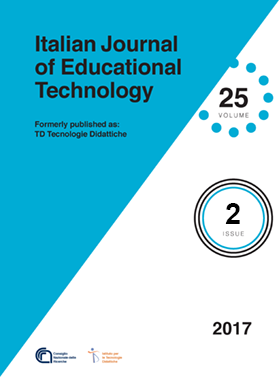From digital computing to computational thinking
Main Article Content
Abstract
Article Details
Section
Authors who publish with this journal agree to the following terms:
- Authors retain copyright and grant the journal right of first publication with the work simultaneously licensed under a Creative Commons CC BY 4.0 Attribution 4.0 International License.
- Authors are able to enter into separate, additional contractual arrangements for the non-exclusive distribution of the journal's published version of the work (e.g., post it to an institutional repository or publish it in a book), with an acknowledgement of its initial publication in this journal.
- Authors are permitted and encouraged to post their work online (e.g., in institutional repositories or on their website) prior to and during the submission process, as it can lead to productive exchanges, as well as earlier and greater citation of published work (See The Effect of Open Access)
References
Abell, S. K. (2008). Twenty years later: Does pedagogical content knowledge remain a useful idea?. International Journal of Science Education, 30(10), 1405-1416. doi:10.1080/09500690802187041
Ammann, D. P., & Offut, J. (2017). Introduction to Software Testing. Cambridge, UK:Cambridge University Press.
Barr, D., Harrison, J., & Conery, L. (2011). Computational Thinking: A Digital Age Skill for Everyone. Learning & Leading with Technology, 38(6), 20–23. Retrieved from http://www.iste.org/docs/learningand-leading-docs/march-2011-computational-thinking-ll386.pdf
Bender, E., Hubwieser, P., Schaper, N., Margaritis, M., Berges, M., Ohrndorf, L., ... & Schubert, S. (2015). Towards a competency model for teaching computer science. Peabody Journal of Education, 90(4), 519-532. doi:10.1080/0161956X.2015.1068082
Bocconi, S., Chioccariello, A., Dettori, G., Ferrari, A., & Engelhardt, K. (2016). Developing computational thinking in compulsory education – Implications for policy and practice. EUR 28295 EN; doi:10.2791/792158
Brennan, K., & Resnick, M. (2012). New frameworks for studying and assessing the development of computational thinking. In Proceedings of the Congress of the American Educational Research Association (pp. 1-25). Vancouver, CA: American Educational Research Association. Retrieved from http://web.media.mit.edu/~kbrennan/files/Brennan_Resnick_AERA2012_CT.pdf
D’Amore B. (2014). Le tante soluzioni di un problema. La Vita Scolastica (GiuntiScuola), 69(1), 25. Retrieved from http://www.dm.unibo.it/rsddm/it/articoli/damore/838%20Le%20tante%20soluzioni%20di%20un%20problema.pdf
D’Amore B., & Fandiño Pinilla, M. I. (2006). Che problema i problemi! L’insegnamento della matematica e delle scienze integrate, 29(6), 647. Retrieved from http://www.dm.unibo.it/rsddm/it/articoli/damore/588%20%20Problemi.pdf
Demo, B. G. (2013, July). Reading data schemas and knowing a db query interface in non technical secondary schools. Paper presented at X World Conference on Computers in Education, Toruń, Poland (pp. 112-120). Retrieved from http://wcce2013.umk.pl/publications/v2/V2.14_196-Demo-fullN.pdf
European Commission (2015). Relazione congiunta del Consiglio e della Commissione sull’attuazione del quadro strategico per la cooperazione europea nel settore dell’istruzione e della formazione (ET 2020) — Nuove priorità per la cooperazione europea nel settore dell’istruzione e della formazione. Gazzetta Ufficiale dell’Unione Europea. Retrieved from http://eur-lex.europa.eu/legal-content/IT/TXT/PDF/?uri=CELEX:52015XG1215(02)&from=IT
European Commission. (2016). A new skills agenda for Europe. Working together to strengthen human capital, employability and competitiveness. Gazzetta Ufficiale dell’Unione Europea. Retrieved from https://ec.europa.eu/transparency/regdoc/rep/1/2016/EN/1-2016-381-EN-F1-1.PDF
Fowler M. and Highsmith J. (2001). The Agile Manifesto. Retrieved from http://agilemanifesto.org/
Halpern, D. (2003). Thought and knowledge: An introduction to critical thinking (4th edition). Mahwah, NJ: Earlbaum.
O. Hazzan, T. Lapidot, N. Ragonis (2014). A Guide to Teaching Computer Science. London, UK: Springer-Verlag
Klahr, D., & Carver, S. M. (1988). Cognitive objectives in a LOGO debugging curriculum: Instruction, learning, and transfer. Cognitive Psychology, 20(3), 362-404. doi:10.1016/0010-0285(88)90004-7
Manilla L., Dagiene, V., Demo, B., Grgurina, N., Mirolo, C., Rolandsson, L., & Settle, A. (2014). Computational Thinking in K-9 Education. In M. Goldweber (Ed.), ITiCSE-WGR ‘14 Proceedings of the Working Group Reports of the 2014 on Innovation & Technology in Computer Science Education Conference (pp. 1-29). Uppsala, SE: Uppsala Universitet. doi:10.1145/2713609.2713610
Olimpo G. (2011). Information flows and graphic knowledge representations. Trentin G. (Eds.), Technology and knowledge flows: the power of network (pp. 91-132). Oxford, UK: Chandos Publishing.
Olimpo, G. (2015). Pensiero computazionale = buona programmazione e non solo. In V. Midoro (Ed.), La scuola ai tempi del digitale (pp. 60-84). Milano, IT: Franco Angeli Editore.
Papert, S. (1980). Mindstorms: Children, computers, and powerful ideas. New York, NY: Basic Books.
Parnas D. (1972). On the criteria to be used in decomposing systems into modules. Communications of the ACM, 14(1), 1053-1058. Retrieved from https://www.cs.umd.edu/class/spring2003/cmsc838p/Design/criteria.pdf
Polya G. (1945). How to Solve It. Princeton, NJ: Princeton University Press (trad. it. Come risolvere i problemi di matematica, UTET Università, Torino, 2016).
Peyton Jones, S., Mitchell, B., & Humphreys, S. (2013, April). Computing at school in the UK. Microsoft Research Paper, 4. Retrieved from https://www.microsoft.com/en-us/research/wp-content/uploads/2016/07/ComputingAtSchoolCACM.pdf
Strödter, C. (2012, November). Data modeling and database systems as part of general education in CSE. In Proceedings of the 7th Workshop in Primary and Secondary Computing Education (pp. 137-140). New York, NY: ACM. doi:10.1145/2481449.2481481
The Royal Society. (2012). Shut down or restart? The way forward for computing in UK Schools. London, UK: The Royal Society. Retrieved from https://royalsociety.org/~/media/education/computing-in-schools/2012-01-12-computing-in-schools.pdf
Verborgh, R. (2013). Programming is an art [blog post]. Retrieved from http://ruben.verborgh.org/blog/2013/02/21/programming-is-an-art/
Weintrop, D., Beheshti, E., Horn, M., Orton, K., Jona, K., Trouille, L., & Wilensky, U. (2016). Defining computational thinking for mathematics and science classrooms. Journal of Science Education and Technology, 25(1), 127-147. doi:10.1007/s10956-015-9581-5
Wing, J. M. (2006). Computational thinking. Communications of the ACM, 49(3), 33-35. doi:10.1145/1118178.1118215
Wing J. (2017). Computational Thinking’s Influence on Research and Education for All. International Journal of Educational Technology, 25(2). doi:10.17471/2499-4324/922

